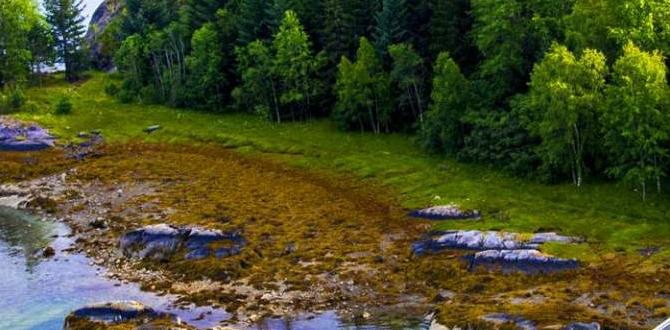Bay of Islands Mid-Range Travel Guide: Essential Tips
Planning a trip to the stunning Bay of Islands doesn’t have to break the bank! This guide offers practical, budget-friendly tips to help you experience its beauty and adventure comfortably. Discover smart ways to save on accommodation, activities, and transport, ensuring a memorable and stress-free getaway without overspending. Get ready for an amazing New Zealand adventure!
New Zealand’s Bay of Islands is a dream destination for many. Imagine sparkling blue waters, lush green islands, and a relaxed pace of life. It’s a place perfect for both adventure seekers and those looking to unwind. But many travelers worry about the cost of visiting such an idyllic spot. You might think a trip to paradise means spending a lot of money, and that can feel overwhelming.
Don’t let budget worries hold you back! This guide is designed to show you how to enjoy the best of the Bay of Islands without needing a huge bank account. We’ll cover everything from finding affordable places to stay to enjoying fantastic experiences that won’t cost a fortune. You’ll learn practical strategies to make your trip comfortable and memorable. Let’s dive into how you can plan your perfect mid-range escape.
Understanding Mid-Range Travel Comfort
Mid-range travel is all about finding that sweet spot between basic backpacking and luxury indulgence. It means prioritizing comfort, reliability, and a good balance of experiences without unnecessary frills or high costs. For the Bay of Islands, this translates to choosing accommodations that offer good value, enjoying a mix of paid activities and free exploration, and opting for transportation that’s convenient and economical.
It’s about smart choices. This might mean staying in a comfortable motel or a well-appointed Airbnb instead of a five-star resort. It could involve booking a popular day cruise that includes lunch, rather than a private charter. For those managing personal care needs, mid-range travel also means having discreet and reliable solutions readily available, like adult or child diapers, ensuring a stress-free experience no matter the duration or activity. The goal is to feel relaxed and prepared, allowing you to fully immerse yourself in the beauty of the Bay of Islands.
When to Visit for Best Value
Timing your visit to the Bay of Islands can significantly impact your budget. While the weather is generally pleasant year-round, certain periods offer better value for money.
Peak Season (December – February)
This is the summer holiday period in New Zealand. Expect the best weather, warm seas, and a vibrant atmosphere. However, this is also the most expensive time to visit. Accommodation prices soar, and popular tours and activities book up quickly. It’s ideal if you don’t mind crowds and higher costs, but for budget-conscious travelers, it’s best to avoid if possible.
Shoulder Seasons (March – May & September – November)
These periods offer a fantastic balance. The weather is still lovely – warm and sunny in autumn (March-May) and delightfully mild in spring (September-November). Crowds are smaller, and prices for flights and accommodation tend to drop. You’ll find more availability for tours and a more relaxed feel. This is often the sweet spot for mid-range travel in the Bay of Islands.
Off-Season (June – August)
This is winter in New Zealand. While the days are shorter and cooler, you can still enjoy many activities, especially if you’re prepared for cooler weather. This is when you’ll find the lowest prices for flights and accommodation. Certain boat trips might have reduced schedules, and some water-based activities may be less appealing, but for whale watching or enjoying the dramatic coastal scenery, it can still be a great time. Plus, fewer crowds mean a more intimate experience.
Accommodation Options on a Budget
Finding comfortable and affordable accommodation is key to a successful mid-range trip. The Bay of Islands offers a variety of options that cater to different preferences and budgets.
Motels and Motor Lodges
These are a staple in New Zealand and offer excellent value. You’ll typically find clean, comfortable rooms with en-suite bathrooms, often including kitchenettes for preparing some of your own meals. Many are conveniently located near town centers and attractions. Look for places slightly outside the main hubs like Paihia or Russell for potentially lower prices.
Holiday Parks
Don’t dismiss holiday parks! While some offer basic campsites, many also have self-contained cabins or motel-style units. These are often very well-equipped, clean, and can be significantly cheaper than traditional hotels or motels, especially for families. They often have shared facilities like kitchens and laundries, which can help save money.
Airbnb and Holiday Homes
Renting a room in a shared house or an entire apartment/bach (holiday home) through platforms like Airbnb can be a great way to save. You get more space, the potential for a full kitchen, and often a more local experience. Booking in advance is crucial, especially during shoulder seasons.
Backpackers Hostels (Private Rooms)
While known for dorm rooms, many hostels also offer private rooms. These can be surprisingly comfortable and are often located in prime spots. They usually offer communal kitchens and social areas, which can be great for meeting other travelers and saving on dining costs.
Booking Tips for Savings:
- Book in Advance: Especially during shoulder seasons, securing your accommodation early can lock in better rates.
- Consider Location: Staying a little outside the main tourist hubs (like Paihia or Russell) might offer lower prices. You can still easily access attractions with minimal travel.
- Look for Deals: Sign up for newsletters from booking sites or directly with accommodations to catch special offers.
- Read Reviews: Always check recent reviews to ensure quality and cleanliness match your expectations for a comfortable stay.
Affordable Transportation in the Bay
Getting around the Bay of Islands without overspending is achievable with a bit of planning. While renting a car offers flexibility, there are other cost-effective ways to explore.
Car Rental (Smartly)
If you opt for car rental, book well in advance. Compare prices from different companies and consider a smaller, fuel-efficient vehicle. Factor in the cost of fuel, as it can be high in New Zealand. For many, renting a car is the most practical way to explore the wider Bay of Islands region, access trailheads, and move between towns like Paihia, Kerikeri, and Russell at your own pace.
Public Transportation and Shuttles
Between the main towns like Paihia and Kerikeri, local bus services exist but can be infrequent. For island hopping or specific scenic routes, scheduled ferries and water taxis are essential. While not as flexible as a car, they are often more economical for dedicated island exploration.
Ferries
Essential for accessing Russell from Paihia. The ferry is frequent, affordable, and offers lovely views. Consider this your primary mode of transport if you’re staying on one side of the bay and primarily exploring its immediate surroundings.
Walking and Cycling
Within towns like Paihia and Russell, walking is the best way to get around. Many attractions are clustered together. Consider renting a bike for a day to explore local trails and coastal paths – a fantastic and active way to see the sights without transportation costs.
Organized Tours with Transport
Many day tours include transportation from your accommodation. If you plan on visiting several attractions spread out over a larger area, a tour might offer better value than trying to navigate it all by yourself and paying for separate transport. Look for tours that include multiple stops.
Budget-Friendly Activities and Experiences
The Bay of Islands is brimming with natural beauty and fascinating history, much of which you can enjoy without spending a fortune.
Free and Low-Cost Natural Wonders
- Beaches: Simply relaxing on the pristine beaches is free! Pack a picnic and enjoy Tapeka Beach for stunning views, or Opua Beach for tranquility.
- Walking Trails: Explore the numerous walking tracks. The walk to the flagpole at Flagstaff Hill (Waitangi Treaty Grounds vicinity, though parking and access might require local knowledge or a small fee depending on the specific path) offers panoramic views. Many coastal paths are also free to access. The Waitangi Track is a beautiful, accessible option.
- Oceanside Drives: Enjoy scenic drives along the coast. The drive from Paihia towards Rawene offers spectacular and often less-traveled coastal vistas.
- Paihia Waterfront: Wander along the Paihia waterfront, watch the boats, and soak in the lively atmosphere.
Affordable Island Exploration
- Ferry to Russell: The short ferry ride from Paihia to Russell is inexpensive and offers beautiful harbor views. Once in Russell, you can explore this historic town on foot, visit the Pompallier Mission, and enjoy its quaint streets and waterfront.
- Hole in the Rock (Group Tours): While a private boat tour can be expensive, group tours to the iconic Hole in the Rock are a popular and relatively affordable way to see the outer islands, dolphins, and dramatic coastlines. Look for deals or book online. Companies often offer competitive pricing.
- Kayaking: Renting a kayak for a few hours allows you to explore sheltered bays at your own pace. It’s a great way to get out on the water without the cost of a larger boat tour.
Historical Sites on a Budget
- Waitangi Treaty Grounds: While not entirely free, the Waitangi Treaty Grounds offer a significant dose of New Zealand history and culture. Investing in the entry fee provides access to the museum, cultural performances, and guided tours, making it a worthwhile experience for understanding the nation’s past. Check their website for any concession or family rates that might apply.
- Kerikeri Mission Station: One of New Zealand’s oldest European buildings, it offers a glimpse into early missionary life. Entry is often by donation or a small fee.
Picnics and Self-Catering
Save money on dining by preparing your own meals. Many accommodations have kitchen facilities. The local supermarkets stock delicious New Zealand produce. Enjoying a picnic lunch on a secluded beach or a scenic viewpoint is an unforgettable experience that costs very little.
Eating Well on a Mid-Range Budget
Enjoying the local flavours of the Bay of Islands doesn’t require deep pockets. With strategic planning, you can eat deliciously and affordably.
Supermarkets and Picnics
This is your number one cost-saver. New Zealand has excellent supermarkets like Countdown and Pak ‘n Save. Stock up on bread, cheese, local fruits, and deli meats for fantastic picnic lunches. Many beaches and parks have picnic tables, making it a perfect way to enjoy the scenery while saving money. Consider simple dinners like pasta or grilled items if your accommodation has cooking facilities.
Local Bakeries and Cafes
Start your day with a “flat white” and a pastry from a local bakery or cafe. Many offer affordable breakfast deals or classic Kiwi pies (savoury pastries) that make for a quick and filling lunch. Supporting local businesses also gives you a taste of the community.
Fish and Chips
A quintessential Kiwi experience! Many seaside towns have fish and chip shops. Grabbing a takeaway pack of fresh fish and chips to enjoy by the water is a classic, reasonably priced meal that feels like a treat.
Happy Hour and Early Bird Specials
Keep an eye out for restaurant promotions. Pubs and bistros often have happy hour deals on drinks and sometimes on appetizers. Some restaurants offer early bird dining specials that provide a set menu at a reduced price for diners who eat earlier in the evening.
Share Meals
If you’re dining out with a companion, consider ordering a larger main course to share. Many New Zealand portions are generous, and sharing can be a great way to reduce costs while still enjoying a restaurant meal. This also applies to appetizers or desserts.
Sample 3-Day Itinerary for Budget-Conscious Travelers
This sample itinerary focuses on experiencing the highlights of the Bay of Islands with a mid-range budget in mind, mixing free activities with cost-effective tours.
Day 1: Paihia & Island Views
- Morning: Arrive in Paihia. Check into your accommodation (e.g., a comfortable motel or holiday park cabin).
- Late Morning: Take the short, affordable ferry to Russell.
- Lunch: Enjoy a picnic lunch brought from Paihia, or grab a cheap and cheerful pie from a Russell bakery.
- Afternoon: Explore Russell on foot. Visit the Christ Church, the oldest surviving church in New Zealand, and wander through the historic streets. Walk up to Flagstaff Hill for panoramic views of the bay.
- Late Afternoon: Ferry back to Paihia.
- Evening: Enjoy fish and chips by the Paihia waterfront, watching the sunset.
Day 2: Marine Adventure & Coastal Beauty
- Morning: Embark on a mid-range boat tour to the Hole in the Rock. Many tours depart from Paihia and include commentary, dolphin spotting opportunities, and a cruise through the iconic hole. Book a reputable tour that offers good value.
- Lunch: Your boat tour might include lunch, or pack sandwiches to have upon your return to Paihia.
- Afternoon: Relax on one of Paihia’s beaches, or rent a kayak for an hour or two to explore the sheltered waters near the shore.
- Evening: Cook dinner at your accommodation if possible, or explore local cafes for affordable meals.
Day 3: History and Kerikeri
- Morning: Travel to the Waitangi Treaty Grounds. While there’s an entry fee, it’s a crucial historical site. Allow ample time to explore the grounds, museum, and cultural performance.
- Lunch: Drive or take a local bus to Kerikeri. Enjoy lunch from a local cafe or supermarket.
- Afternoon: Explore the historic Kerikeri Mission Station (Stone Store and Kemp House). Wander through the charming town center.
- Late Afternoon: Enjoy a scenic drive back towards your departure point, perhaps stopping at a viewpoint.
Note: This itinerary can be adjusted based on your interests and transport. If you have a rental car, you can explore further afield, such as the scenic drive to Matauri Bay or the Kauri Museums near Whangarei if time permits and you’re heading south.
Packing Essentials for Comfort and Convenience
Packing smart ensures you have everything you need for a comfortable and enjoyable trip, minimizing the need to buy forgotten items at higher prices. For mid-range travel, focus on versatile items.
Clothing
- Layers: The weather can change quickly. pack light, breathable layers like t-shirts, a long-sleeved top, a fleece or sweater, and a waterproof and windproof jacket.
- Comfortable Footwear: You’ll be doing a lot of walking. Pack comfortable walking shoes or sturdy sandals. Water shoes can be useful for rocky beaches or boat trips.
- Swimwear: Even if you’re not planning to swim extensively, opportunities for a dip in the clear waters might arise.
- Sun Protection: Sunscreen, a wide-brimmed hat, and sunglasses are essential, even on cloudy days. The New Zealand sun is strong.
Personal Care and Health
- Medications: Bring any prescription medications and a basic first-aid kit (band-aids, antiseptic wipes, pain relievers).
- Insect Repellent: Especially important for evenings and areas with bush.
- Toiletries: While most accommodations provide basics, bring your preferred brands.
- Discreet Personal Care Items: For some travelers, carrying discreet and reliable personal care items like adult diapers or child diapers is a significant comfort. Ensure you have an adequate supply that is easy to pack and use discreetly. Brands like Depend or Abena offer various absorbency levels suitable for travel, and compression garments can also assist with comfort and confidence during longer journeys or activities.
Gear and Accessories
- Reusable Water Bottle: Stay hydrated and reduce plastic waste. Many places offer free tap water refills.
- Daypack: Essential for carrying essentials on day trips – water, snacks, camera, sunscreen, and a light jacket.
- Camera/Phone: To capture the stunning scenery. Ensure you have chargers and power banks.
- Book or E-reader: For downtime.
- Travel Adapter: New Zealand






